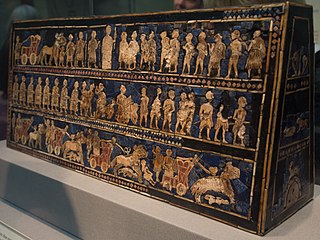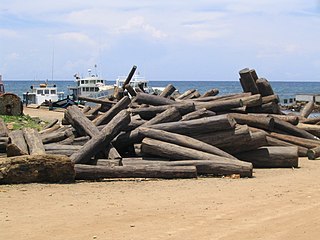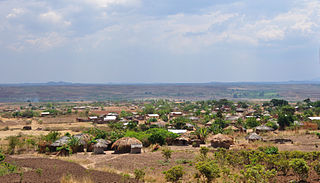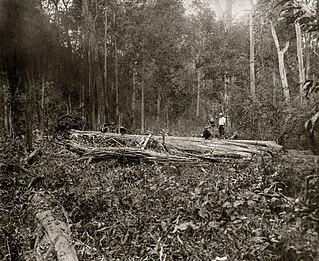
Ancient history is a time period from the beginning of writing and recorded human history through late antiquity. The span of recorded history is roughly 5,000 years, beginning with the development of Sumerian cuneiform script. Ancient history covers all continents inhabited by humans in the period 3000 BC – AD 500, ending with the expansion of Islam in late antiquity. The three-age system periodizes ancient history into the Stone Age, the Bronze Age, and the Iron Age, with recorded history generally considered to begin with the Bronze Age. The start and end of the three ages vary between world regions. In many regions the Bronze Age is generally considered to begin a few centuries prior to 3000 BC, while the end of the Iron Age varies from the early first millennium BC in some regions to the late first millennium AD in others.

Environmental determinism is the study of how the physical environment predisposes societies and states towards particular economic or social developmental trajectories. Jared Diamond, Jeffrey Herbst, Ian Morris, and other social scientists sparked a revival of the theory during the late twentieth and early twenty-first centuries. This "neo-environmental determinism" school of thought examines how geographic and ecological forces influence state-building, economic development, and institutions. While archaic versions of the geographic interpretation were used to encourage colonialism and eurocentrism, modern figures like Diamond use this approach to reject the racism in these explanations. Diamond argues that European powers were able to colonize, due to unique advantages bestowed by their environment, as opposed to any kind of inherent superiority.

Subsistence agriculture occurs when farmers grow crops on smallholdings to meet the needs of themselves and their families. Subsistence agriculturalists target farm output for survival and for mostly local requirements. Planting decisions occur principally with an eye toward what the family will need during the coming year, and only secondarily toward market prices. Tony Waters, a professor of sociology, defines "subsistence peasants" as "people who grow what they eat, build their own houses, and live without regularly making purchases in the marketplace".

Illegal logging is the harvest, transportation, purchase, or sale of timber in violation of laws. The harvesting procedure itself may be illegal, including using corrupt means to gain access to forests; extraction without permission, or from a protected area; the cutting down of protected species; or the extraction of timber in excess of agreed limits. Illegal logging is a driving force for a number of environmental issues such as deforestation, soil erosion and biodiversity loss which can drive larger-scale environmental crises such as climate change and other forms of environmental degradation.

The Neolithic Revolution, also known as the First Agricultural Revolution, was the wide-scale transition of many human cultures during the Neolithic period in Afro-Eurasia from a lifestyle of hunting and gathering to one of agriculture and settlement, making an increasingly large population possible. These settled communities permitted humans to observe and experiment with plants, learning how they grew and developed. This new knowledge led to the domestication of plants into crops.

Underdevelopment, in the context of international development, reflects a broad condition or phenomena defined and critiqued by theorists in fields such as economics, development studies, and postcolonial studies. Used primarily to distinguish states along benchmarks concerning human development—such as macro-economic growth, health, education, and standards of living—an "underdeveloped" state is framed as the antithesis of a "developed", modern, or industrialized state. Popularized, dominant images of underdeveloped states include those that have less stable economies, less democratic political regimes, greater poverty, malnutrition, and poorer public health and education systems.

The earliest humans were hunter gatherers who were living in small, family groupings. Even then there was considerable trade that could cover long distances. Archaeologists have found that evidence of trade in luxury items like precious metals and shells across the entirety of the continent.
An agrarian society, or agricultural society, is any community whose economy is based on producing and maintaining crops and farmland. Another way to define an agrarian society is by seeing how much of a nation's total production is in agriculture. In agrarian society, cultivating the land is the primary source of wealth. Such a society may acknowledge other means of livelihood and work habits but stresses the importance of agriculture and farming. Agrarian societies have existed in various parts of the world as far back as 10,000 years ago and continue to exist today. They have been the most common form of socio-economic organization for most of recorded human history

James Campbell Scott was an American political scientist and anthropologist specializing in comparative politics. He was a comparative scholar of agrarian and non-state societies.
Internal colonialism is the uneven effects of economic development on a regional basis, otherwise known as "uneven development" as a result of the exploitation of minority groups within a wider society which leads to political and economic inequalities between regions within a state. This is held to be similar to the relationship between a metropole and a colony, in colonialism proper. The phenomenon leads to the distinct separation of the dominant core from the periphery in an empire.

Nanyang is the Chinese term for the warmer and fertile geographical region along the southern coastal regions of China and beyond, otherwise known as the 'South Sea' or Southeast Asia. The term came into common usage in self-reference to the large ethnic Chinese migrant population in Southeast Asia, and is contrasted with Xiyang, which refers to the Western world, Dongyang, which refers to Japan. The Chinese press regularly uses the term to refer to the region stretching from Yunnan Province to Singapore and from Myanmar (Burma) to Vietnam ; in addition, the term also refers to Brunei, East Malaysia, East Timor, Indonesia and the Philippines in the region it encompasses.

A stateless society is a society that is not governed by a state. In stateless societies, there is little concentration of authority. Most positions of authority that do exist are very limited in power, and they are generally not permanent positions, and social bodies that resolve disputes through predefined rules tend to be small. Different stateless societies feature highly variable economic systems and cultural practices.
Nutritional anthropology is the study of the interplay between human biology, economic systems, nutritional status and food security. If economic and environmental changes in a community affect access to food, food security, and dietary health, then this interplay between culture and biology is in turn connected to broader historical and economic trends associated with globalization. Nutritional status affects overall health status, work performance potential, and the overall potential for economic development for any given group of people.

Hill people, also referred to as mountain people, is a general term for people who live in the hills and mountains. This includes all rugged land above 300 metres (980 ft) and all land above 2,500 metres (8,200 ft) elevation. The climate is generally harsh, with steep temperature drops between day and night, high winds, runoff from melting snow and rain that cause high levels of erosion and thin, immature soils.

Invasive species are a crucial threat to many native habitats and species of the United States and a significant cost to agriculture, forestry, and recreation. An invasive species refers to an organism that is not native to a specific region and poses significant economic and environmental threats to its new habitat. The term "invasive species" can also refer to feral species or introduced diseases. Some introduced species, such as the dandelion, do not cause significant economic or ecologic damage and are not widely considered as invasive. Economic damages associated with invasive species' effects and control costs are estimated at $120 billion per year.

Human trafficking in Texas is the illegal trade of human beings as it occurs in the state of Texas. It is a modern-day form of slavery and usually involves commercial sexual exploitation or forced labor, both domestic and agricultural.

Oudomxay is a province of Laos, located in the northwest of the country. Its capital is Muang Xai.

Agriculture in Mexico has been an important sector of the country’s economy historically and politically even though it now accounts for a very small percentage of Mexico’s GDP. Mexico is one of the cradles of agriculture with the Mesoamericans developing domesticated plants such as maize, beans, tomatoes, squash, cotton, vanilla, avocados, cacao, and various spices. Domestic turkeys and Muscovy ducks were the only domesticated fowl in the precolumbian era, and small dogs were also raised for food. There were no large domesticated animals, such as cattle or pigs.

Deforestation in Myanmar led to a reduction in forest cover from 70% of the country in 1948 to 48% by 2014. Myanmar possesses the largest expanse of tropical forest in mainland Southeast Asia, which contains high biodiversity. As of 2010, Myanmar's living forest biomass held 1,654 million metric tons of carbon and over 80 endemic species.
The means by which agriculture expanded into the Philippines is argued by many different anthropologists and an exact date of its origin is unknown. However, there are proxy indicators and other pieces of evidence that allow anthropologists to get an idea of when different crops reached the Philippines and how they may have gotten there. Rice is an important agricultural crop today in the Philippines and many countries throughout the world import rice and other products from the Philippines.















